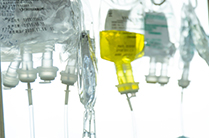Overview
What Is Myelodysplastic Syndrome (MDS)?
Myelodysplastic syndromes (MDS) are a group of diseases that cause immature blood cells (called blasts) to accumulate in the bone marrow. This leads to a shortage of mature blood cells, including red blood cells, white blood cells and platelets. In addition, the mature blood cells that are made may not function properly. Although MDS can affect people of all ages, the average age of onset is about 70 years.
Syndromes of MDS include:
• 5q syndrome (named after the chromosomal defect that causes the symptoms)
• Hypoplastic MDS
• MDS with myelofibrosis
• MDS with prominent eosinophilia or monocytosis
MDS and Leukemia
MDS are a generally indolent (slow-moving) type of cancer. It may stay stable for a prolonged period, but about 30% of the time, the syndromes are a precursor to a more advanced condition, such as acute myeloid leukemia (AML). For this reason, MDS is sometimes called as smoldering leukemia or pre-leukemia.
Causes
Risk Factors for MDS
Anything that increases your risk of getting a disease is called a risk factor. Having a risk factor does not mean that you will get cancer. In addition, the absence of risk factors does not mean that you will not get cancer. If you have any risk factors for MDS, talk to your doctor to discuss next steps.
In 60-70% of MDS patients, we cannot identify a specific cause. However, there are certain risk factors that increase your chances of developing MDS.
Exposure to certain types of chemicals can increase your risk. This includes people who have:
• Received radiation therapy
• Received chemotherapy with alkylating agents (such as chlorambucil, cyclophosphamide and melphalan)
• Had exposure to industrial solvents (such as benzene) or ionizing radiation
Other risk factors include:
• Genetic disorders (in rare cases), including Down syndrome, Fanconi anemia, neurofibromatosis type 1 or Noonan syndrome
• Having a brother or sister, especially a twin, with leukemia
• Exposure to cigarette smoke or alcohol before birth
• A history of aplastic anemia
Symptoms
Symptoms of Myelodysplastic Syndromes (MDS)
Symptoms of MDS are similar to other medical conditions. It is important to see your doctor if you experience any symptoms so we can provide a prompt and accurate diagnosis.
Symptoms of MDS include:
• Shortness of breath
• Weakness or feeling tired
• Easy bruising or bleeding
• Petechiae (flat, pinpoint spots under the skin caused by bleeding)
Diagnosis
Diagnostic Tests for MDS
If you experience any symptoms of MDS, we will use a combination of tests to confirm a diagnosis.
A number of tests may be used to diagnose MDS, including:
Physical exam and history is an exam of the body to check general signs of health, including checking for signs of disease, such as lumps or anything else that seems unusual. A history of the patient's health habits and past illnesses and treatments will also be taken.
Please provide your medical records to us before your appointment. At the visit itself, the nurses and doctors will ask additional questions and carry out a detailed physical exam.
A biopsy is a procedure in which tissue samples are removed from the body by a needle or during surgery, for examination under a microscope to determine if cancer or other abnormal cells are present.
By examining and performing tests on the biopsy sample, pathologists and other experts can determine what kind of cancer is present, whether it is likely to be fast or slow growing, and what genetic abnormalities it may have. This information is important in deciding the best type of treatment. Open surgery is sometimes performed to obtain a biopsy, but in most cases, tissue samples can be obtained without open surgery using interventional radiology techniques.
Some biopsies can be performed in a doctor's office, while others need to be done in a hospital setting. Most biopsies require use of an anesthetic to numb the area and may require sedation.
Bone marrow aspiration and biopsy involves the removal of bone marrow, blood, and a small piece of bone by inserting a needle into the hipbone or breastbone. This type of biopsy is performed either from the sternum (breastbone) or the iliac crest hipbone (the bone area on either side of the pelvis on the lower back area). The skin is cleansed and a local anesthetic is given to numb the area. A long, rigid needle is inserted into the marrow, and cells are aspirated for study; this step is occasionally uncomfortable. A pathologist views the bone marrow, blood, and bone under a microscope to look for signs of cancer. A core biopsy (removing a small bone 'chip' from the marrow) may follow the aspiration.
Chest X-rays are an imaging tool that we commonly use to diagnose conditions affecting the heart, lungs, blood vessels, airways, and other structures in the chest. This noninvasive test provides images that show details about bones, organs, and tissues.
A blood chemistry study is a procedure in which a blood sample is checked to measure the amounts of certain substances released into the blood by organs and tissues in the body. An unusual (higher or lower than normal) amount of a substance can be a sign of disease in the organ or tissue that makes it.
A complete blood count (CBC) measures the size, number, and maturity of the different blood cells in a specific volume of blood. This is one of the most common tests performed.
• Red blood cells are important for carrying oxygen and fighting anemia and fatigue. The hemoglobin portion of the CBC measures the oxygen carrying capacity of the red blood cells while the hematocrit measures the percentage of red blood cells in the blood.
• White blood cells fight infection. Increased numbers of white blood cells, therefore, may indicate the presence of an infection. Decreased levels may indicate certain rheumatic diseases or reaction to medication.
• Platelets prevent the body from bleeding and bruising easily. It is usually performed to check for a blood infection.
In this laboratory test, cells in a sample of blood or bone marrow are viewed under a microscope to look for certain changes in the structure or number of chromosomes in the lymphocytes.
Immunophenotyping is a test in which the cells in a sample of blood or bone marrow are looked at under a microscope to find out if malignant lymphocytes (cancer) began from the B lymphocytes or the T lymphocytes. The process identifies cells based on the types of antigens or markers on the surface of the cell. This process is used to diagnose specific types of leukemia and lymphoma by comparing the cancer cells to normal cells of the immune system.
During this procedure, a sample of blood is checked for blast cells, number and kinds of white blood cells, number of platelets, and changes in the shape of the blood cells.
Staging
Myelodysplastic Syndromes (MDS) Staging
• MDS Staging: French American British (FAB) Classification
• Refractory anemia (RA): <5% marrow blasts
• Refractory anemia with ring sideroblasts (RARS)
• Refractory anemia with excess blasts (RAEB): 5-20% blasts (now called AML)
• Refractory anemia with excess blasts in transformation (RAEB-T): 21-30% blasts
• Chronic myelomonocytic leukemia (CMML): 5-20% blasts
Acute myeloid leukemia (AML) is considered to be associated with >30% marrow blasts.
• MDS Staging: World Health Organization Typing System
A newer, slightly more complicated system for classifying MDS has been developed by the World Health Organization (WHO). Along with the cell type and maturity of the cells, this system takes into account other factors, such as chromosome changes in the cells and whether or not the leukemia is the result of previous cancer treatments. It classifies MDS according to factors that differ from those of the FAB system, including:
• Considers molecular and chromosomal (cytogenetic) data
• Defines RAEB-T to be a leukemia rather than a subtype of MDS
• Defines patients with more than 20% blasts in marrow as having acute myeloid leukemia (AML)
• Includes the category of myelodysplastic syndromes/myeloproliferative diseases (MDS/MPD)
• Includes juvenile myelomonocytic leukemia (JMML) and chronic myelomonocytic leukemia (CMML) in the MDS/MPD category
According to the WHO typing system, MDS includes the following subtypes:
• Refractory cytopenia with unilineage dysplasia (RCUD), which includes subtypes:
• Refractory anemia (RA)
• Refractory neutropenia (RN)
• Refractory thrombocytopenia (RT)
• Refractory cytopenia with multilineage dysplasia (RCMD): <5% blasts
• Refractory anemia with ring sideroblasts (RARS): <5% blasts with RS
• Refractory anemia with excess blasts type 1 (RAEB-1): 5-9% blasts
• Refractory anemia with excess blasts type 2 (RAEB-2): 10-19% blasts
• MDS with isolated deletion 5q (5q-syndrome): <5% blasts
• Unclassifiable MDS (MDS-u)
• MDS Staging: International Prognostic Scoring System (IPSS)
The International Prognostic Scoring System (IPSS) aids doctors in assessing the severity of a patient's MDS. The IPSS uses three "prognostic indicators" to predict the course of the patient's disease:
• The percentage of blast cells in the marrow
• The type of chromosomal changes, if any, in the marrow cells
• The presence of one or more low blood cell counts (cytopenias)
Each indicator is rated according to its severity, and doctors come up with a "score" that describes the patient's risk. Risk categories are:
• Low
• Intermediate-1
• Intermediate-2
• High
The low and intermediate categories are sometimes combined into a lower risk group; the intermediate-2 and high categories are sometimes combined into a higher risk group.
A treatment plan is designed around the patient's score and the doctor's personal observations of the patient.
• MDS Staging: Revised International Prognostic Scoring System (IPSS-R)
Our program also uses the revised International Prognostic Scoring System (the IPSS-R) for Myelodysplastic Syndromes. This revised IPSS-R includes five rather than three cytogenetic prognostic subgroups with specific and new classifications of a number of less common cytogenetic subsets, splitting the low marrow blast percentage value, and depth of low blood counts (cytopenias). In addition to the major prognostic variables of marrow blasts, cytogenetics and peripheral low blood counts, cytopenias, additive features for survival include patient age, performance status, serum ferritin and LDH.
Treatments
MDS Treatments
Different treatments are available based on your specific subtype of MDS and any related problems.
MDS treatment options include:
• Chemotherapy: The use of anticancer drugs to shrink or kill cancerous cells and reduce cancer spreading to other parts of the body.
• Bone Marrow transplantation: We replace the blood-forming cells that were destroyed by cancer treatment. This helps the bone marrow recover and continue to make healthy blood cells. For more information about Bone Marrow Transplantation, please click here.
• Supportive care: This refers to care we provide that helps relieve pain or discomfort caused by the disease or its treatment. Supportive care may include transfusions and antibiotics.
• Transfusion therapy: We give you red blood cells, white blood cells or platelets to replace blood cells destroyed by disease or cancer treatment. The blood may be donated from another person, or we may take it from you before treatment and stored it until needed.
• Watchful waiting: Watchful waiting is closely monitoring a patient's condition without giving any treatment until symptoms appear or change.
Low-intensity therapy
Low-intensity therapy usually does not require a hospital stay. You will most likely experience fewer side effects. Low-intensity therapy includes medications such as:
• Erythropoietin or G-CSF plus erythropoietin
• 5 azacytidine
• Decitabine
• Lenalidomide
• Deferasirox (iron chelating agent)
High-intensity therapy
High-intensity therapy usually requires a hospital stay. You may experience side effects from the treatments. Our team will work with you to minimize any pain or discomfort you experience.
• Bone marrow transplantation: standard and reduced intensity conditioning
• Intensive chemotherapy
(The content above extract from stanfordhealthcare.org)
-
-
Diseases ·
-














 京公网安备13108202000843号
京公网安备13108202000843号